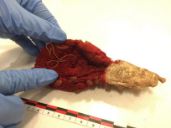Discovery in the Depot
“Several specimens of this manufacture are met with in nearly every museum, and the Indian Section of the Colonial Exhibition in London 1886 contained a great many beautiful silk and cotton Shawls, produced by this same process; but the Exhibition did not include the mode of manufacture in its successive stages.”
Felix Driessen first commissioned these mysterious looking objects so that he could return to Leiden with accurate steps of the tie-dye craft. He donated the objects in December 1887 to the Volkenkunde Museum, and a couple of years later in 1889, his publication ‘Tie and Dye-work Manufactured at Semarang’ reveals the brilliant illustration of these objects as stages of the tie dye process from Indonesia.
The preservation of both sources means we were recently able to match up each object to each step in the tie-dye process. When they were uncovered in the museum depot, the little bundles of fabric surprised us with their materials, colour, and size! When we saw the objects and the illustration side by side, we noticed how perfectly they matched. It is so exciting to bring them back together for the first time in almost 135 years.
(But before moving forward, click below to see a tie dye tutorial)
](https://micrio.thingsthattalk.net/bpLkR/views/max/128x128.jpg)

